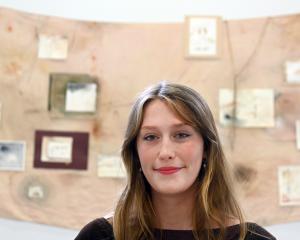A year as University of Otago Frances Hodgkins Fellow has built on Patrick Lundberg's early excitement about his art. Charmian Smith reports.
When you are young you think your youthful energy will last forever, says Patrick Lundberg, 2014 Frances Hodgkins Fellow at Otago University.
''Draft Copy'', an exhibition of his work over the past year, opens at the Hocken Gallery on Saturday.
Lundberg (31) was born in Sweden but brought up in New Zealand.
His father is Swedish and his mother a New Zealander.
He sort of fell into art he says, encouraged by his parents, teachers and friends.
''Anything you are halfway good at when you are young, you are pushed in that direction, so I ended up going to art school straight out of high school and it worked out happily,'' he said.
''It's invigorating to feel you are competent in something and that's why people keep going in lots of different fields.''
However, he didn't particularly enjoy his first year at Elam School of Fine Arts in Auckland.
Like a lot of teenagers he expected something that indulged his skills rather than the critical thinking course he was confronted with.
''That was really hard but by the time I got to second year I moved into the painting department and that became very good, possibly because I encountered some incredibly good teachers. Maybe things were a little more focused. Then I got really excited about it.''
His fellowship year in Dunedin has built on that excitement and given him a glimmer of what the future could be if he had a self-sustaining practice and could work all the time, he says.
''Maybe something like this fellowship gives young practitioners the drive to go on and achieve this kind of situation off their own bat.''
Since graduating he has worked about four days a week in retail to support his art practice, but his goal now is to find a way to spend more time on his art and less time supporting himself with a day job.
Lundberg thinks of himself as a painter but takes a lot of his thinking from different fields.
While studying in the painting department he was taught by a sculptor and in his last year he was in an interdisciplinary studio, which he found suited him.
When he left art school he made a break with the large oil paintings he was doing there, he said.
''I found myself in a new situation outside art school, with less space and less time, and that way of working felt too cumbersome. For a few years after art school I made wall paintings and wall drawings, things that were very temporary.''
Work he made for exhibitions at the time no longer exists apart from the documentation.
Now with painting and assembling small objects that can be arranged on a wall - or even a floor - he feels he is returning to making durable objects but retaining some of the lightness and flexibility of the temporary approach.
''It's a bit like making an instrument. I'm sitting in the studio making instruments that can be played at a later date. You can really play them any way you want,'' he said
He still thinks of himself as a painter because he paints on objects, sets of small things that can be assembled on a wall.
Some of his shapes are made from clay, others are found or bought objects which he paints, sometimes intriguingly delicately.
He composes them in the manner of a painting and uses painterly vocabulary, he explains.
Some of his works have been incised, the paint removed in certain ways which he thinks of as reverse painting.
''All the works are a little bit of play with the format of painting. They are always making reference to it. I would say that's quite a key thing.''
This year he has been developing ideas about time in his work, he says.
He sees Western painting as a spatially-biased medium but wants to make time the primary dimension in his work.
His early works were temporary, but those he is working on at present are both durable and subject to change - ''always on the verge of change because of the lack of a guiding instruction of how to arrange them'', he says.
He sells his works through dealers in Auckland, Wellington and Melbourne, where his current exhibition ''Games III'' is on show.
''They are not installations that disappear. These particular works endure in a certain way which means they can be purchased and kept and moved around as the owner wants. They are purchasing something that has contingency and flexibility.''
Unlike some of the other fellows who have worked collaboratively, Lundberg has worked alone, quietly in his studio.
''This year has been more about slowly and carefully extrapolating on different things that were present in the work when I moved into the studio. It's a year of different outcomes, but this year is certainly not the year of radical breakthroughs or anything like that.''
However, he says, although he's found it valuable to lock himself away in his studio to work, it's also been a social year and he has met a lot of interesting people.
''Maybe I've sort of settled on something I'm happy with for a while, longer than I've been happy with anything before. That's not to say that's what I'll do for the rest of my life. I feel more strongly about this work than other work I have made.''
Lundberg will be returning to Auckland, but is excited to show the local community what he has been doing during his fellowship year.














